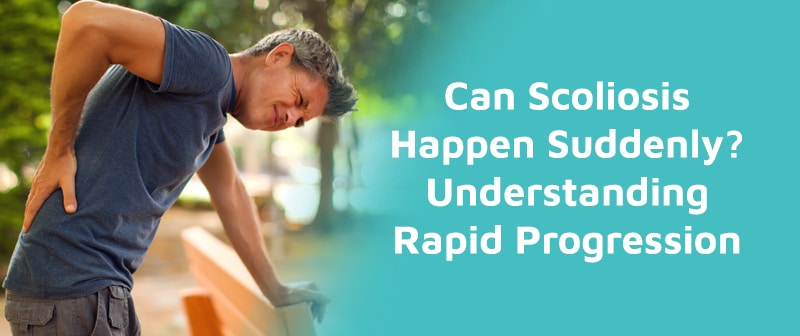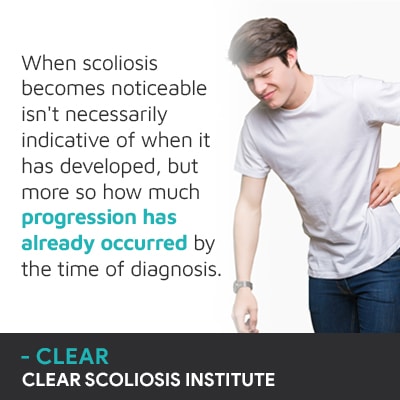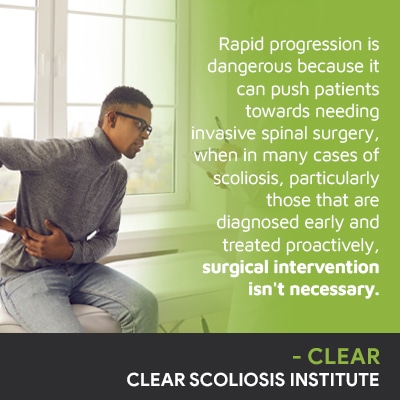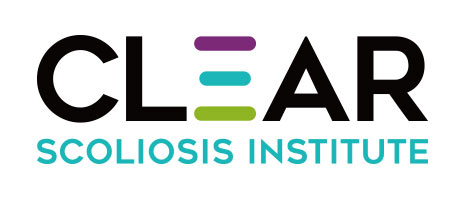
While scoliosis can progress suddenly with growth spurts, it tends to develop and progress over time. The nature of scoliosis is to get more severe, and progression is triggered by growth. Rapid and unpredictable growth spurts cause rapid-phase progression. Adolescents going through puberty are the most likely to experience rapid-phase progression.
Scoliosis can progress over time. When a condition is diagnosed doesn't necessarily mean it has just developed. In many cases, scoliosis isn't diagnosed until it has progressed and its signs are more overt. Rapid progression can be triggered by rapid growth spurts.
I've heard parents say it seems like their child's scoliosis developed overnight, but what's more likely is that they had a significant growth spurt and progressed significantly as a result.
A scoliosis diagnosis means an unnatural sideways curvature of the spine has developed, and as a 3-dimensional condition, the spine also rotates.
Treatment results are never guaranteed, but early detection is associated with treatment success; conditions are more responsive to treatment while mild.
Smaller curves are simpler to treat.
In order to diagnose scoliosis, a physical examination that includes taking the patient's family history and medical history, examining the spine while the patient bends forward (Adam's forward bend test), and a scoliosis X-ray is performed.
A scoliosis X-ray is necessary to see what's happening in and around the spine, to confirm there is a rotational component, and to determine the patient's Cobb angle measurement.
When scoliosis develops, certain vertebrae are becoming unnaturally tilted, and this shift in position disrupts the spine's alignment and causes the spine to bend and twist unnaturally, and the Cobb angle determines just how severe the curve is.
A Cobb Angle measurement is determined during X-ray and tells me how far out of alignment the spine is and classifies conditions based on severity: mild scoliosis, moderate scoliosis, or severe scoliosis.
The higher a patient's Cobb angle, the more severe the condition, and a minimum Cobb angle of 10 degrees is needed to be diagnosed as scoliosis.
Mild scoliosis is diagnosed with Cobb angles of between 10 and 25 degrees; moderate scoliosis involves Cobb angle measurements of between 25 and 40 degrees, and severe scoliosis is diagnosed at 40+ degrees.
As scoliosis progresses, the unnatural spinal curve is going to increase in size, and this increases the condition's uneven forces, and their effects.
The main effect of scoliosis in children is postural deviation, and the main symptom of scoliosis in adults is pain; scoliosis pain can involve muscle pain, back pain, and most often, pain felt in the extremities due to nerve compression.
Scoliosis is also associated with a muscular imbalance as the unnatural spinal curve is pulling its surrounding muscles in different directions, overusing some and under-using others, which can cause painful muscle spasms.
Uneven shoulders and hips are often the earliest telltale signs of childhood scoliosis, and uneven shoulder blades, a rib cage arch, an uneven waistline, and arms and legs that hang at different lengths are additional postural changes that can occur.
When mild, the signs of scoliosis can be subtle and difficult for anyone, other than a scoliosis expert, to notice, and this is why most cases of scoliosis are diagnosed once they have progressed from mild to moderate scoliosis, and the signs become more noticeable.

As scoliosis progresses in children, the postural changes get more noticeable, and disruptions to balance, coordination, and gait are additional signs of scoliosis to watch for.
There are also different types of scoliosis, and condition type is determined by its underlying cause.
The most common type of scoliosis overall is idiopathic scoliosis, and idiopathic scoliosis has no known cause and is, instead, considered to be multifactorial: caused by multiple variables, or a combination of variables, that can change from person to person.
When scoliosis becomes noticeable isn't necessarily indicative of when it's developed, but more so how much progression has already occurred by the time of diagnosis.
Scoliosis affects all ages, but the most prevalent type of scoliosis overall is adolescent idiopathic scoliosis, diagnosed between the ages of 10 and 18.
While we don't fully understand what triggers the condition's initial onset, we know it's growth that triggers progression.
Scoliosis progressing means the spine's unnatural bend and twist is getting worse, and this means the spine is getting more rigid.
The more progression occurs, the more rigid the spine is, and this makes it less responsive to treatment; the first phase of treatment often involves increasing spinal flexibility to prepare the spine for the next phase of treatment that involves chiropractic adjustments.
Rapid progression means a large growth spurt can cause the condition to progress rapidly, increasing the patient's Cobb angle and condition severity.
Rapid progression is dangerous because it can push patients towards needing invasive spinal surgery, when in many cases of scoliosis, particularly those that are diagnosed early and treated proactively, surgical intervention isn't necessary.
Scoliosis treatment has two main approaches: traditional and conservative.
Traditional scoliosis treatment tends to funnel patients towards invasive spinal fusion surgery because its watch-and-wait strategy is more reactive and does little to prevent scoliosis from getting worse.
Scoliosis surgery involves fusing the curve's most-tilted vertebrae into one solid bone, and this is done to prevent them from becoming more tilted over time (progression), and metal rods are commonly attached to the spine with pedicle screws to hold it in place.
Scoliosis surgery can straighten a bent spine, but it's also known to cost the spine in terms of its strength and function.
A fused spine can be more vulnerable to injury, less flexible, and often has a reduced range of motion that can lead to activity restrictions and impact a patient's overall quality of life.
Modern conservative treatment offers a proactive response to a diagnosis by starting treatment immediately.

Different phases of treatment and treatment disciplines work together such as physical therapy, scoliosis-specific exercises, chiropractic care, corrective bracing, and rehabilitation.
If areas of restricted movement or hypermobility are located within the spine, the first phase of treatment uses a variety of therapies and exercises to help increase the spine's flexibility so it's receptive to the next phase of treatment.
As a structural condition, scoliosis needs to be impacted on a structural level, and this is worked towards through a series of chiropractic techniques and adjustments that can reposition the curve's most-tilted vertebrae.
Increasing the spine's stability is another key facet of conservative treatment because curvature reductions have to be held, and this involves increasing core muscles strength so the spine is optimally supported and stabilized.
For childhood scoliosis, corrective bracing can also help complement other treatment disciplines by pushing the spine into a straighter alignment.
Conservative treatment offers a non operative treatment alternative, and many scoliosis cases benefit from a proactive chiropractic-centered approach.
So while we don't fully understand the nature of scoliosis onset, we do fully understand the condition's progressive nature.
Scoliosis can progress suddenly but tends to develop/progress more slowly over time; when rapid progression is most often an issue is during adolescence due to the unpredictable and rapid growth spurts of puberty.
Adult idiopathic scoliosis will still progress, but it tends to be slower as growth is no longer occurring and skeletal maturity has been reached.
Idiopathic scoliosis in adults is the perfect example of how difficult it can be to recognize scoliosis developing; these are cases of adolescent idiopathic scoliosis that were neither diagnosed nor treated. These cases progressed into adulthood, which is when skeletal maturity is reached and conditions become compressive and painful.
It's pain that brings most adults in for a diagnosis and treatment, so particularly in cases of adult scoliosis, conditions diagnosed could have been progressing slowly over the years.
Adults who develop scoliosis fresh in adulthood with no previous history, develop degenerative scoliosis, and onset is caused by degenerative changes in the spine affecting older adults; in most cases, this involves degenerative disc disease.
What scoliosis patients need to understand is that when scoliosis becomes noticeable and is diagnosed doesn't always mean it has just developed, but what can happen suddenly is progression, and this is because progression is triggered by growth spurts.
Progression, however, can often be prevented through a proactive treatment approach, and particularly when conditions are diagnosed early and treated proactively.

CLEAR provides a unique and innovative way of understanding scoliosis. Sign up to receive facts and information you won’t find anywhere else.
